The AMD Kabini Review: A4-5000 APU Tested
by Jarred Walton on May 23, 2013 12:00 AM ESTKabini Gaming and Battery Life
We've covered the general performance and some synthetic graphics tests. What about actual games? Well, here’s what our (admittedly punishing) 2013 gaming suite looks like on Kabini. These are the "Value" results, as the "Mainstream" and "Enthusiast" settings are unplayable on anything without a dGPU (though those results are available in Mobile Bench if you're interested).
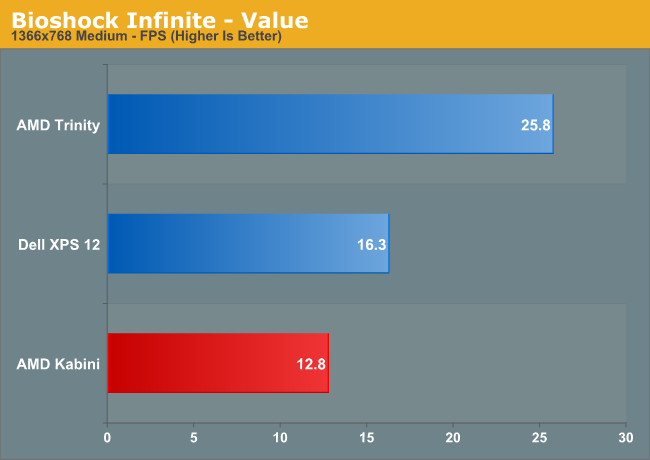

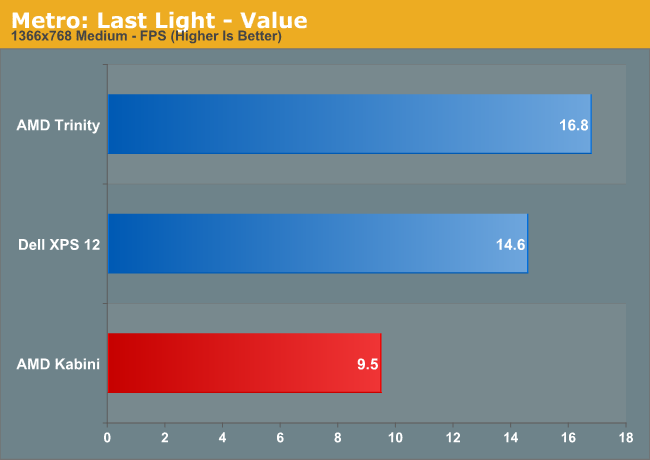
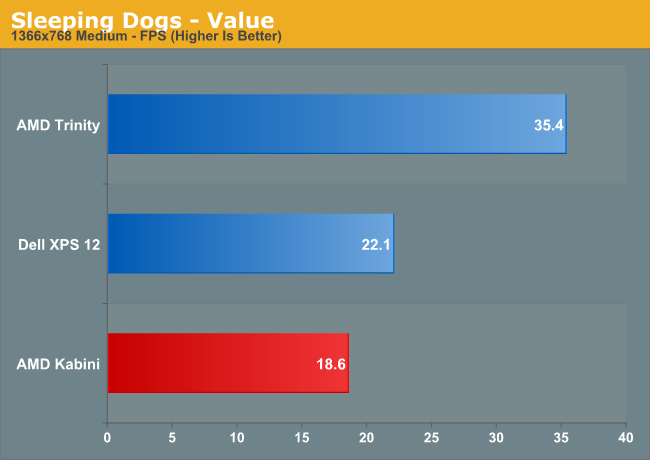
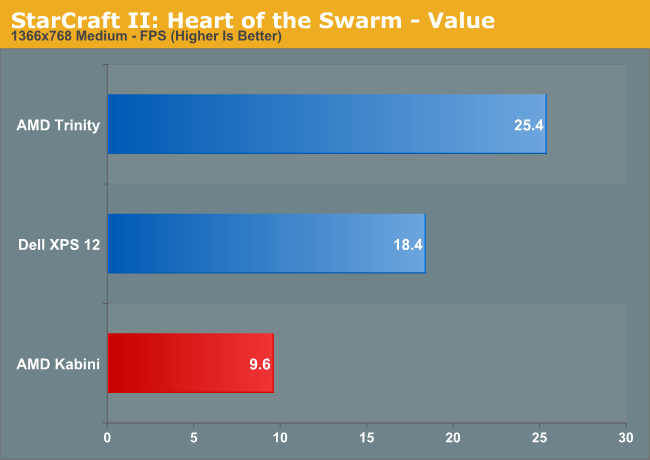
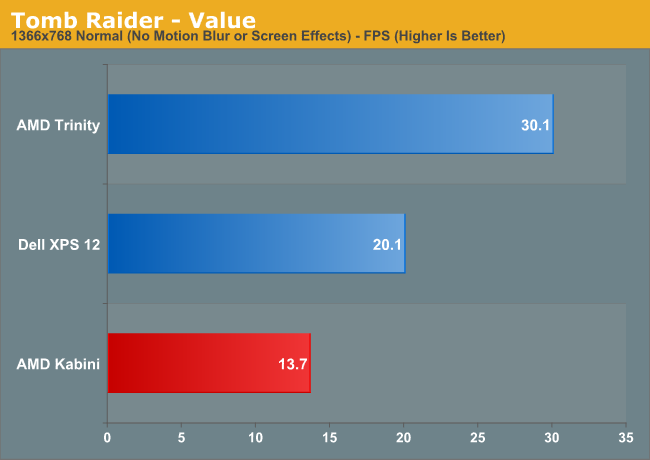
The short summary is that not a single game manages to crest the 30FPS mark, and I even ran additional tests at the minimum quality settings (at 1366x768) to see if I could improve the results. Sadly, I couldn’t, at least not enough to make the games playable; the best I managed was around 25 FPS in Bioshock, Skyrim, and Tomb Raider at minimum detail, and most titles remained in the sub-20 FPS range. Titles that tend to be more taxing on the CPU side of things like StarCraft II are even worse, with frame rates in StarCraft II being half of what IVB ULV gets at our Value (medium quality minus antialiasing) preset.
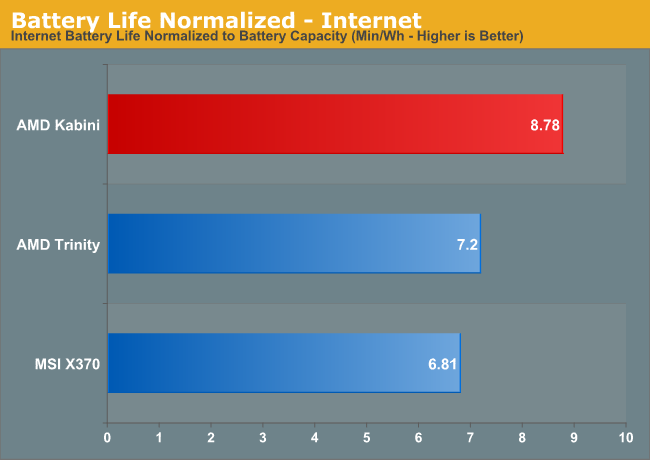
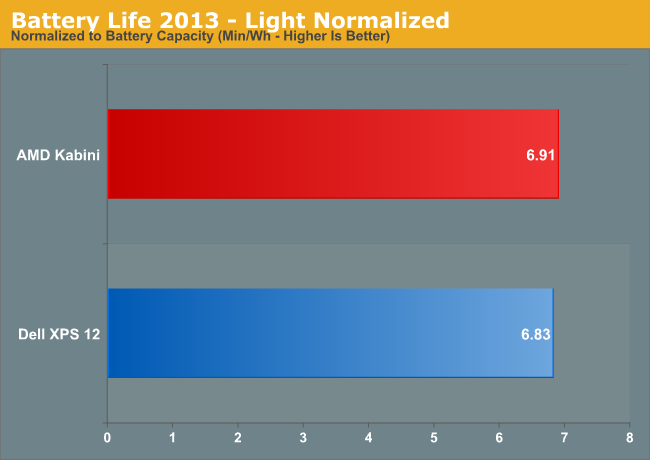
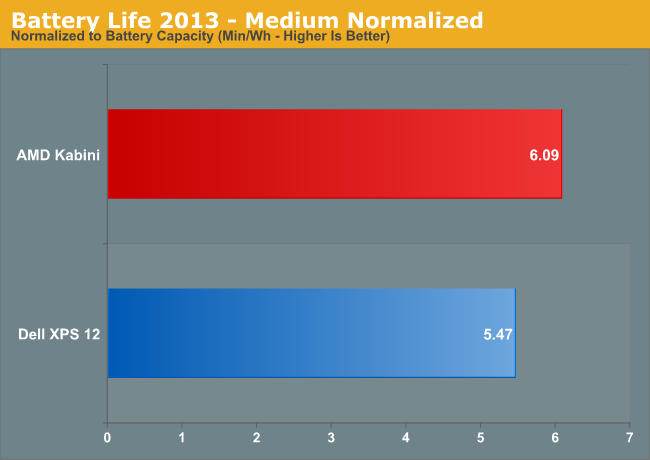
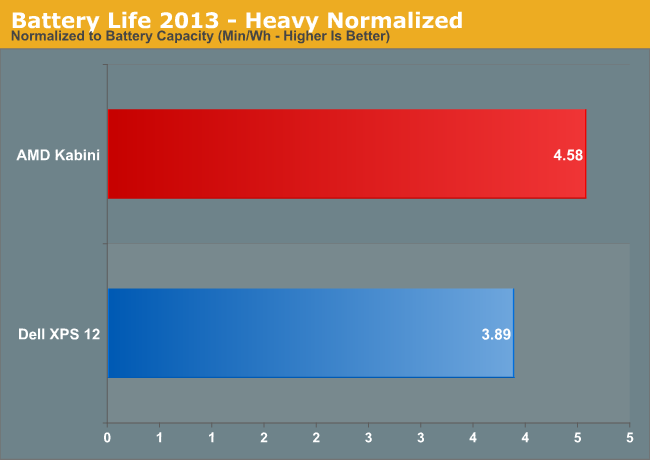
The good news is that not only is Kabini noticeably faster than Brazos, but it’s also mighty frugal when it comes to power use. We don’t have any Brazos laptops handy, so we had to use our older Internet battery life test as a comparison point (100 nits instead of 200 nits); in that test, Kabini topped 6.5 hours with a 45Wh battery. The MSI X370 we’re using as a comparison point did last a bit longer, but it also has a 64Wh battery. In terms of normalized power use, the Kabini laptop ends up being 29% more efficient, and that’s with a 14” AHVA 1080p panel going up against a 13.3” TN 768p display. We’re not quite able to compare apples to apples, but Kabini definitely looks like a good improvement over Brazos in power use.
The power story is even better when we look at ULV Ivy Bridge and standard Trinity APUs. Using our new battery life tests, which push the hardware a lot harder than our previous tests, Kabini delivers normalized battery life that’s at least equal to IVB ULV (our “Light” test), and in the more taxing Medium and Heavy tests Kabini beats ULV by 11% and 18%, respectively. Of course the IVB ULV system is still faster, and it’s also likely to cost twice what we expect Kabini laptops to sell for, but lower cost Celeron and Pentium ULV parts shouldn't be all that different. Also of note is that we don’t know yet how Haswell will fare in these same tests, but that’s an area Intel seems to be focusing on for their next CPU; that’s a story for next month….










130 Comments
View All Comments
whyso - Thursday, May 23, 2013 - link
Because no one cares about Sandy Bridge ULV considering its now end of life. They also tested a lot of highly synthetic benchmarks. i3 ULV ivy notebooks can be had for $400 on newegg, i5 ULV notebooks cost $500 (http://www.newegg.com/Product/Product.aspx?Item=N8... sale yes but sales happen all the time). Also for the greater part of its lifetime, kabini will compete with haswell.Gaugamela - Thursday, May 23, 2013 - link
No, Kabini will compete with Pentiums. You guys keep forgeting that.And Ivy notebooks will be replaced and Kabini notebooks won't compete with them for most of it's shelf life. As for sales, do you think you won't see sales of Kabini notebooks?
Just because there's a small overlap of vendors clearing up inventory of Ivy notebooks doesn't invalidate that Kabini is a new chip and won't compete with Ivy Bridge for most of its life.
whyso - Thursday, May 23, 2013 - link
No, if an i5 ULV notebook costs $500, an i3 ULV notebook costs $400 and a kabini notebook costs $450 then the kabini is competing with i3/i5 and NOT pentium. Pricewise it competes with i3 and possibly i5. Haswell ULV will launch in a few months. Bobcat launched what? two years ago. With a similar lifetime (hope its shorter) jaguar will be competing with haswell for the vast majority of its lifetime.t.s - Thursday, May 23, 2013 - link
Yep. The barrier IMO, is OEM. OEM tend to hiking the price. When bobcat E350 first out, the average price is ~$360. What the hell. With $460, i can get 2x performance with sandy bridge i3.If only AMD want to build their own machine (laptop and desktop).
Gaugamela - Thursday, May 23, 2013 - link
A Kabini notebook costs 400$. And that's without having into account promotions, which WILL happen just as they happen to those precious i3 Ivy Bridges of yours. You seem to forget that promotions happen to all notebooks. And if you keep bringing ULV i3 Ivy Bridges for that price, then guess what? I'll get a TRINITY APU notebook instead for that price! Because I can also get them!! And they have a much stronger GPU power than Kabini, and Ivy Bridge and I can also get some quite decent ultrathins.whyso - Thursday, May 23, 2013 - link
Trinity and ivy bridge ULV are very similar in gpu performance. ULV ivy demolishes ULV trinity cpu wise though.Gaugamela - Friday, May 24, 2013 - link
The top Trinity LV APU (the A10-4655M) beats the Ivy Bridge ULVs in terms of GPU performance. The issue is that there's barely any notebooks for sale with it (The Samsung Series 5 ultrathin is one, the HP Sleekbook another).The A8-4455M is available in the Asus U38N and a Lenovo model and that one is weak. It's comparable to a Ivy Bridge i3 em terms of CPU/GPU performance (weaker single-thread but better multi-thread - more cores).
However, Trinity powered notebooks are usually cheaper than Ivy Bridge ones and you can get them with great promotions now.
whyso - Friday, May 24, 2013 - link
They are very similar and within error range (+/- around 10%).Gaugamela - Friday, May 24, 2013 - link
No, they're not. A A10-4655M with dual channel RAM beats the living crap of a HD4000. You just don't want to admit that. Go dig for benchmarks before spouting falsehoods.whyso - Friday, May 24, 2013 - link
No, mobile amd apus do very good in 3d mark but poorly in games because games have more cpu load (unlike 3dmark which is very cpu light) and the gpu can't boost as high. For instance the 7660G generally ties with the 630m in 3dmark but loses by about 20% in games. Thats a 25 watt part so it will do better than the 17 watt ULV but beat the living crap? NO. Even the 7660G only beats the HD4000 on average by 30%, move that down to ULV and the difference is less.